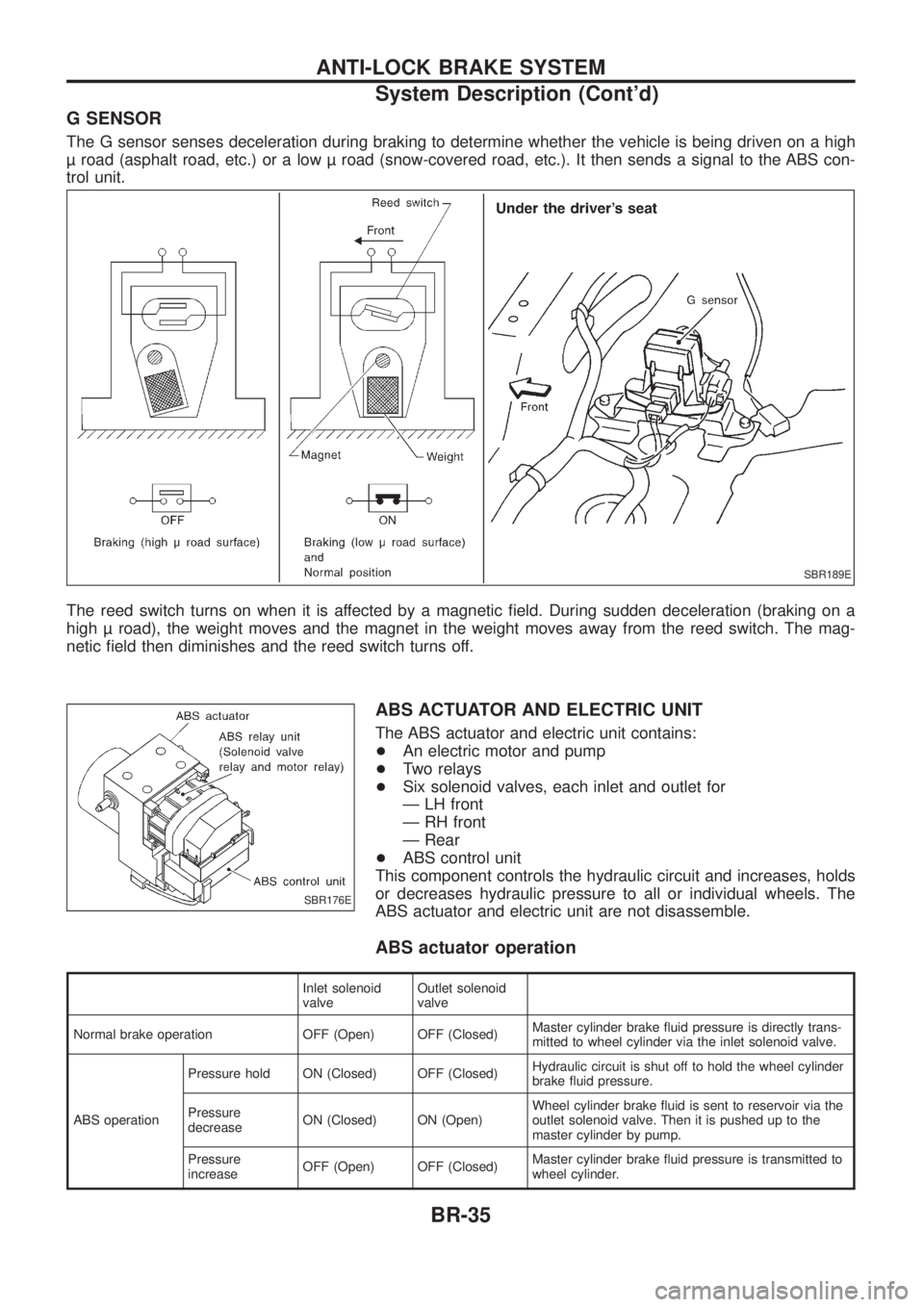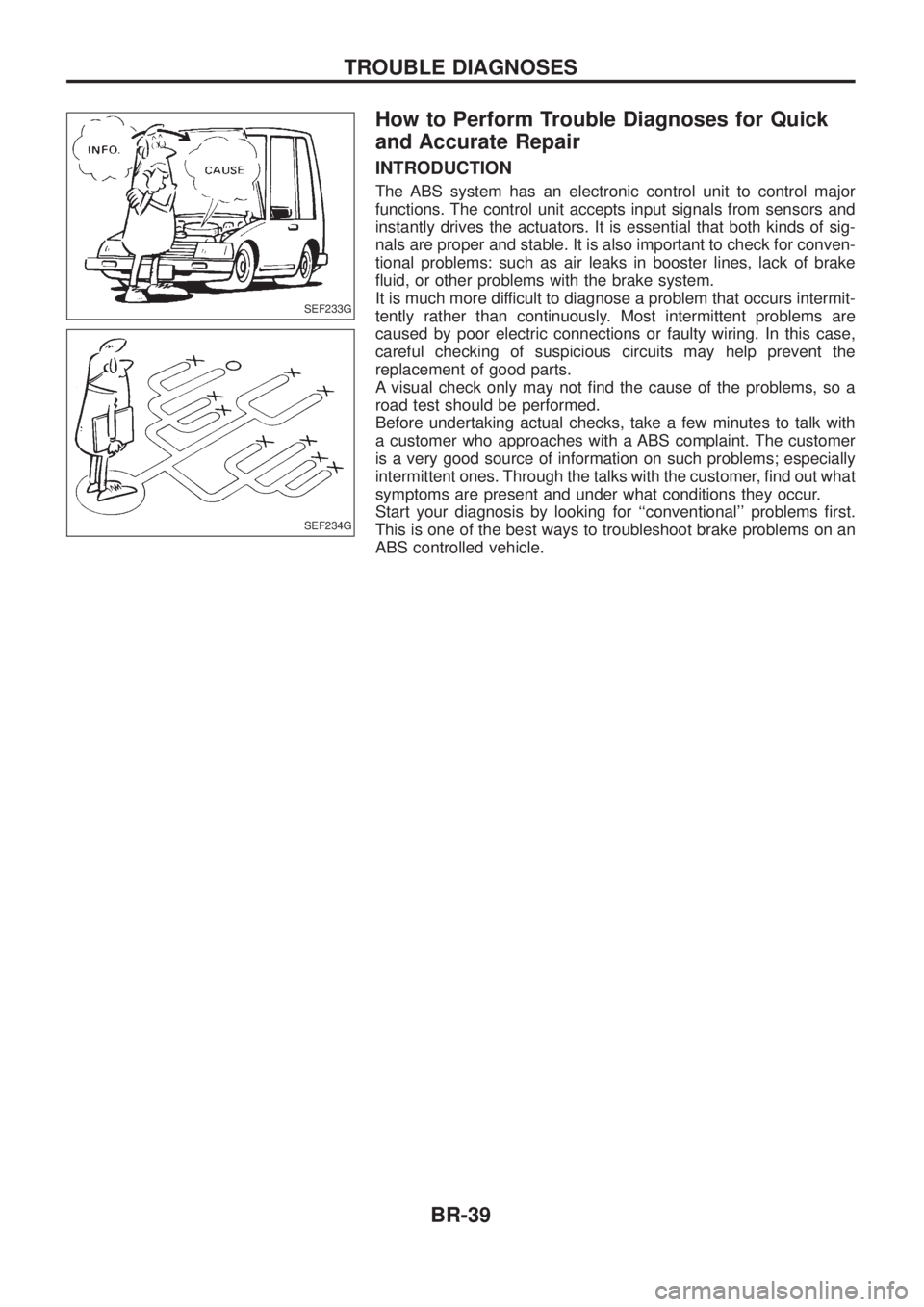Page 39 of 1226

G SENSOR
The G sensor senses deceleration during braking to determine whether the vehicle is being driven on a high
road (asphalt road, etc.) or a low road (snow-covered road, etc.). It then sends a signal to the ABS con-
trol unit.
The reed switch turns on when it is affected by a magnetic ®eld. During sudden deceleration (braking on a
high road), the weight moves and the magnet in the weight moves away from the reed switch. The mag-
netic ®eld then diminishes and the reed switch turns off.
ABS ACTUATOR AND ELECTRIC UNIT
The ABS actuator and electric unit contains:
+An electric motor and pump
+ Two relays
+ Six solenoid valves, each inlet and outlet for
Ð LH front
Ð RH front
Ð Rear
+ ABS control unit
This component controls the hydraulic circuit and increases, holds
or decreases hydraulic pressure to all or individual wheels. The
ABS actuator and electric unit are not disassemble.
ABS actuator operation
Inlet solenoid
valve Outlet solenoid
valve
Normal brake operation OFF (Open) OFF (Closed) Master cylinder brake ¯uid pressure is directly trans-
mitted to wheel cylinder via the inlet solenoid valve.
ABS operation Pressure hold ON (Closed) OFF (Closed)
Hydraulic circuit is shut off to hold the wheel cylinder
brake ¯uid pressure.
Pressure
decrease ON (Closed) ON (Open) Wheel cylinder brake ¯uid is sent to reservoir via the
outlet solenoid valve. Then it is pushed up to the
master cylinder by pump.
Pressure
increase OFF (Open) OFF (Closed) Master cylinder brake ¯uid pressure is transmitted to
wheel cylinder.
SBR189E
SBR176E
ANTI-LOCK BRAKE SYSTEM
System Description (Cont'd)
BR-35
Page 40 of 1226
Removal and Installation
CAUTION:
Be careful not to damage sensor edge and sensor rotor teeth.
When removing the front wheel hub or rear axle shaft
assembly, disconnect the ABS wheel sensor from the assem-
bly and move it away.
FRONT WHEEL SENSOR
SBR187E
ANTI-LOCK BRAKE SYSTEM
BR-36
Page 41 of 1226
REAR WHEEL SENSOR
G SENSOR
Always replace G sensor if bumped or dropped. Otherwise,
performance characteristics of G sensor will be changed,
which in turn changes ABS control performance characteris-
tics.
SBR188E
SBR190E
ANTI-LOCK BRAKE SYSTEM
Removal and Installation (Cont'd)BR-37
Page 42 of 1226
ABS ACTUATOR AND ELECTRIC UNIT
Removal
1. Disconnect battery cable.
2. Drain brake ¯uid. Refer to ``Changing Brake Fluid'', BR-3.
3. Remove mounting bracket ®xing bolts and nuts.
4. Disconnect connector, brake pipes and remove ®xing nuts.
Installation
CAUTION:
After installation, re®ll brake ¯uid. Then bleed air. Refer to
Bleeding Brake System'', BR-4.
1. Connect brake pipes temporarily.
2. Tighten ®xing bolts and nuts.
3. Tighten brake pipes.
4. Connect connector and battery cable.
SBR191E
ANTI-LOCK BRAKE SYSTEM
Removal and Installation (Cont'd)BR-38
Page 43 of 1226

How to Perform Trouble Diagnoses for Quick
and Accurate Repair
INTRODUCTION
The ABS system has an electronic control unit to control major
functions. The control unit accepts input signals from sensors and
instantly drives the actuators. It is essential that both kinds of sig-
nals are proper and stable. It is also important to check for conven-
tional problems: such as air leaks in booster lines, lack of brake
¯uid, or other problems with the brake system.
It is much more difficult to diagnose a problem that occurs intermit-
tently rather than continuously. Most intermittent problems are
caused by poor electric connections or faulty wiring. In this case,
careful checking of suspicious circuits may help prevent the
replacement of good parts.
A visual check only may not ®nd the cause of the problems, so a
road test should be performed.
Before undertaking actual checks, take a few minutes to talk with
a customer who approaches with a ABS complaint. The customer
is a very good source of information on such problems; especially
intermittent ones. Through the talks with the customer, ®nd out what
symptoms are present and under what conditions they occur.
Start your diagnosis by looking for ``conventional'' problems ®rst.
This is one of the best ways to troubleshoot brake problems on an
ABS controlled vehicle.
SEF233G
SEF234G
TROUBLE DIAGNOSES
BR-39
Page 47 of 1226
Wiring Diagram Ð ABS Ð
TBR099
TROUBLE DIAGNOSES
BR-43
Page 48 of 1226
TBR100
TROUBLE DIAGNOSES
Wiring Diagram Ð ABS Ð (Cont'd)BR-44
Page 49 of 1226
TBR101
TROUBLE DIAGNOSES
Wiring Diagram Ð ABS Ð (Cont'd)BR-45